A Critical Analysis: Kouzes and Posner's Leadership Challenge Model
VerifiedAdded on 2023/06/10
|10
|2418
|81
Essay
AI Summary
This essay provides a detailed analysis of Jim Kouzes and Barry Posner's "The Leadership Challenge," exploring their research-backed insights into exemplary leadership practices. It examines the authors' viewpoints, purpose, and main points, focusing on the five practices of exemplary lead...
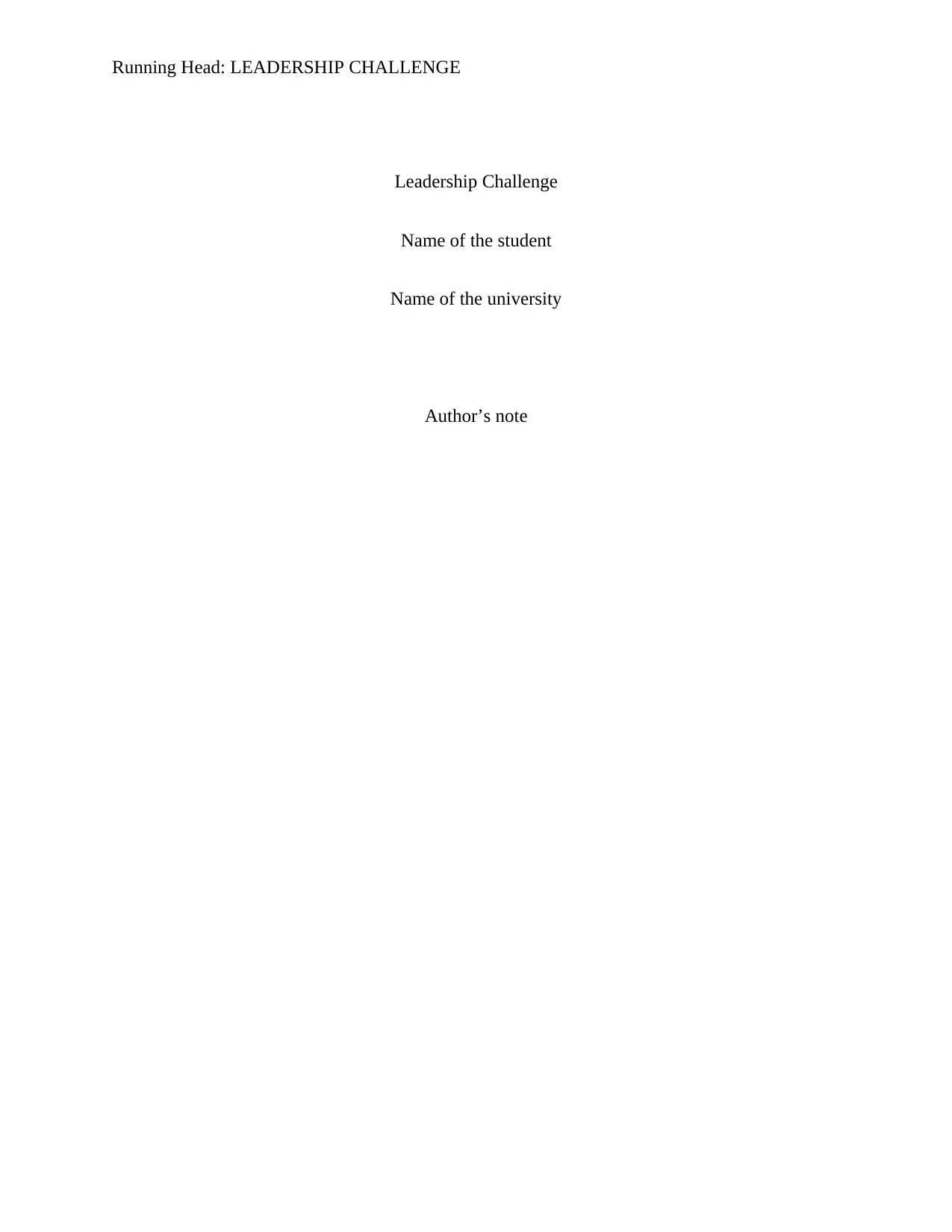
Running Head: LEADERSHIP CHALLENGE
Leadership Challenge
Name of the student
Name of the university
Author’s note
Leadership Challenge
Name of the student
Name of the university
Author’s note
Paraphrase This Document
Need a fresh take? Get an instant paraphrase of this document with our AI Paraphraser
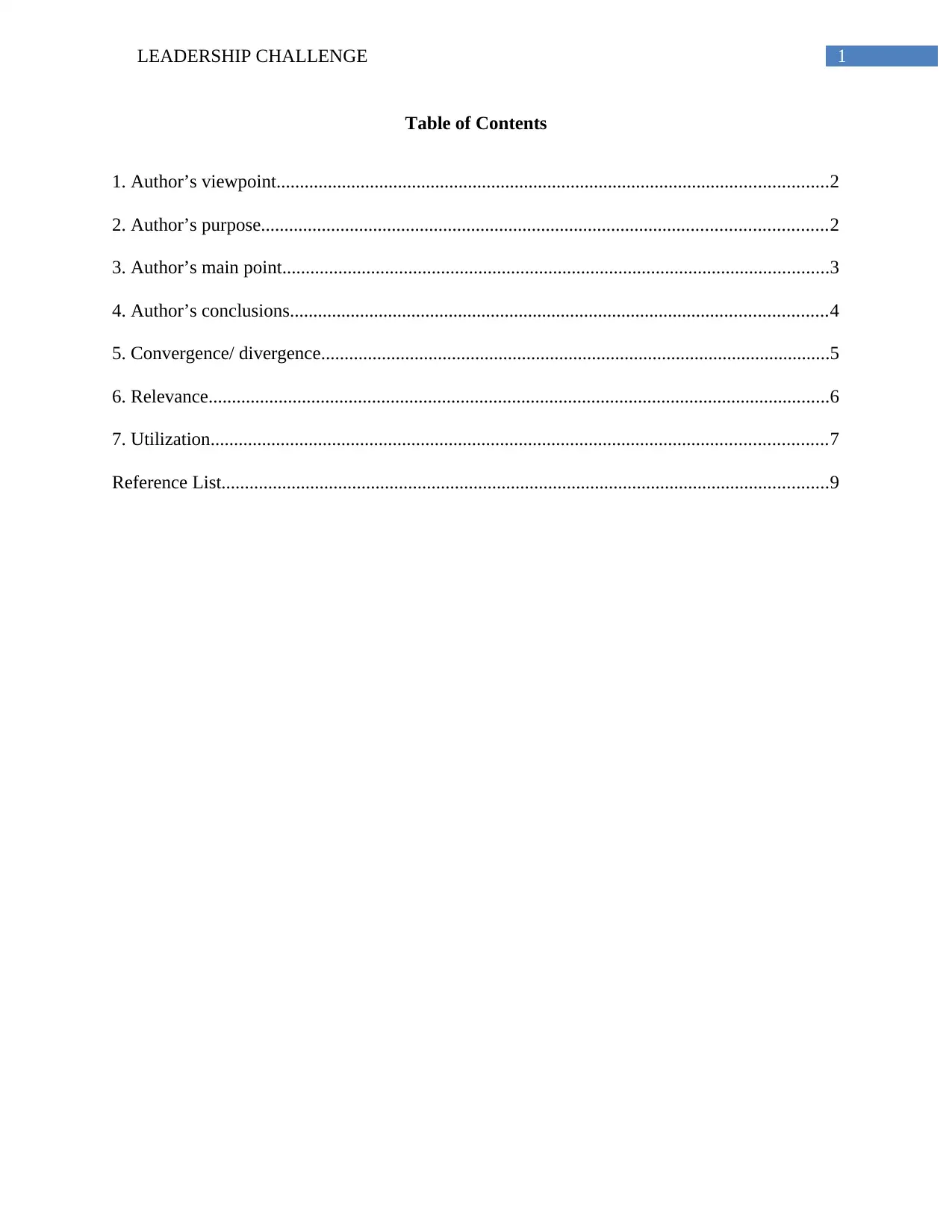
1LEADERSHIP CHALLENGE
Table of Contents
1. Author’s viewpoint......................................................................................................................2
2. Author’s purpose.........................................................................................................................2
3. Author’s main point.....................................................................................................................3
4. Author’s conclusions...................................................................................................................4
5. Convergence/ divergence.............................................................................................................5
6. Relevance.....................................................................................................................................6
7. Utilization....................................................................................................................................7
Reference List..................................................................................................................................9
Table of Contents
1. Author’s viewpoint......................................................................................................................2
2. Author’s purpose.........................................................................................................................2
3. Author’s main point.....................................................................................................................3
4. Author’s conclusions...................................................................................................................4
5. Convergence/ divergence.............................................................................................................5
6. Relevance.....................................................................................................................................6
7. Utilization....................................................................................................................................7
Reference List..................................................................................................................................9
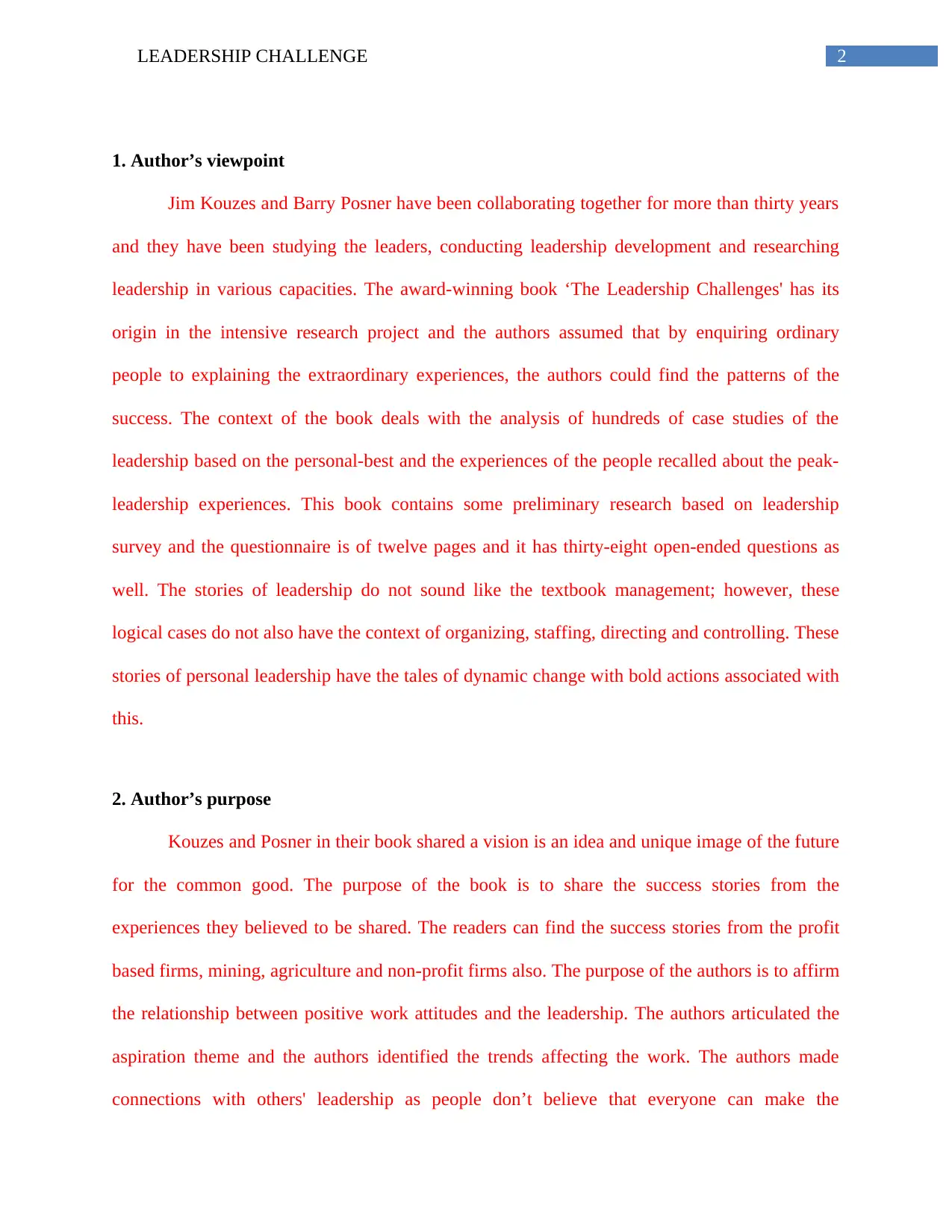
2LEADERSHIP CHALLENGE
1. Author’s viewpoint
Jim Kouzes and Barry Posner have been collaborating together for more than thirty years
and they have been studying the leaders, conducting leadership development and researching
leadership in various capacities. The award-winning book ‘The Leadership Challenges' has its
origin in the intensive research project and the authors assumed that by enquiring ordinary
people to explaining the extraordinary experiences, the authors could find the patterns of the
success. The context of the book deals with the analysis of hundreds of case studies of the
leadership based on the personal-best and the experiences of the people recalled about the peak-
leadership experiences. This book contains some preliminary research based on leadership
survey and the questionnaire is of twelve pages and it has thirty-eight open-ended questions as
well. The stories of leadership do not sound like the textbook management; however, these
logical cases do not also have the context of organizing, staffing, directing and controlling. These
stories of personal leadership have the tales of dynamic change with bold actions associated with
this.
2. Author’s purpose
Kouzes and Posner in their book shared a vision is an idea and unique image of the future
for the common good. The purpose of the book is to share the success stories from the
experiences they believed to be shared. The readers can find the success stories from the profit
based firms, mining, agriculture and non-profit firms also. The purpose of the authors is to affirm
the relationship between positive work attitudes and the leadership. The authors articulated the
aspiration theme and the authors identified the trends affecting the work. The authors made
connections with others' leadership as people don’t believe that everyone can make the
1. Author’s viewpoint
Jim Kouzes and Barry Posner have been collaborating together for more than thirty years
and they have been studying the leaders, conducting leadership development and researching
leadership in various capacities. The award-winning book ‘The Leadership Challenges' has its
origin in the intensive research project and the authors assumed that by enquiring ordinary
people to explaining the extraordinary experiences, the authors could find the patterns of the
success. The context of the book deals with the analysis of hundreds of case studies of the
leadership based on the personal-best and the experiences of the people recalled about the peak-
leadership experiences. This book contains some preliminary research based on leadership
survey and the questionnaire is of twelve pages and it has thirty-eight open-ended questions as
well. The stories of leadership do not sound like the textbook management; however, these
logical cases do not also have the context of organizing, staffing, directing and controlling. These
stories of personal leadership have the tales of dynamic change with bold actions associated with
this.
2. Author’s purpose
Kouzes and Posner in their book shared a vision is an idea and unique image of the future
for the common good. The purpose of the book is to share the success stories from the
experiences they believed to be shared. The readers can find the success stories from the profit
based firms, mining, agriculture and non-profit firms also. The purpose of the authors is to affirm
the relationship between positive work attitudes and the leadership. The authors articulated the
aspiration theme and the authors identified the trends affecting the work. The authors made
connections with others' leadership as people don’t believe that everyone can make the
⊘ This is a preview!⊘
Do you want full access?
Subscribe today to unlock all pages.

Trusted by 1+ million students worldwide
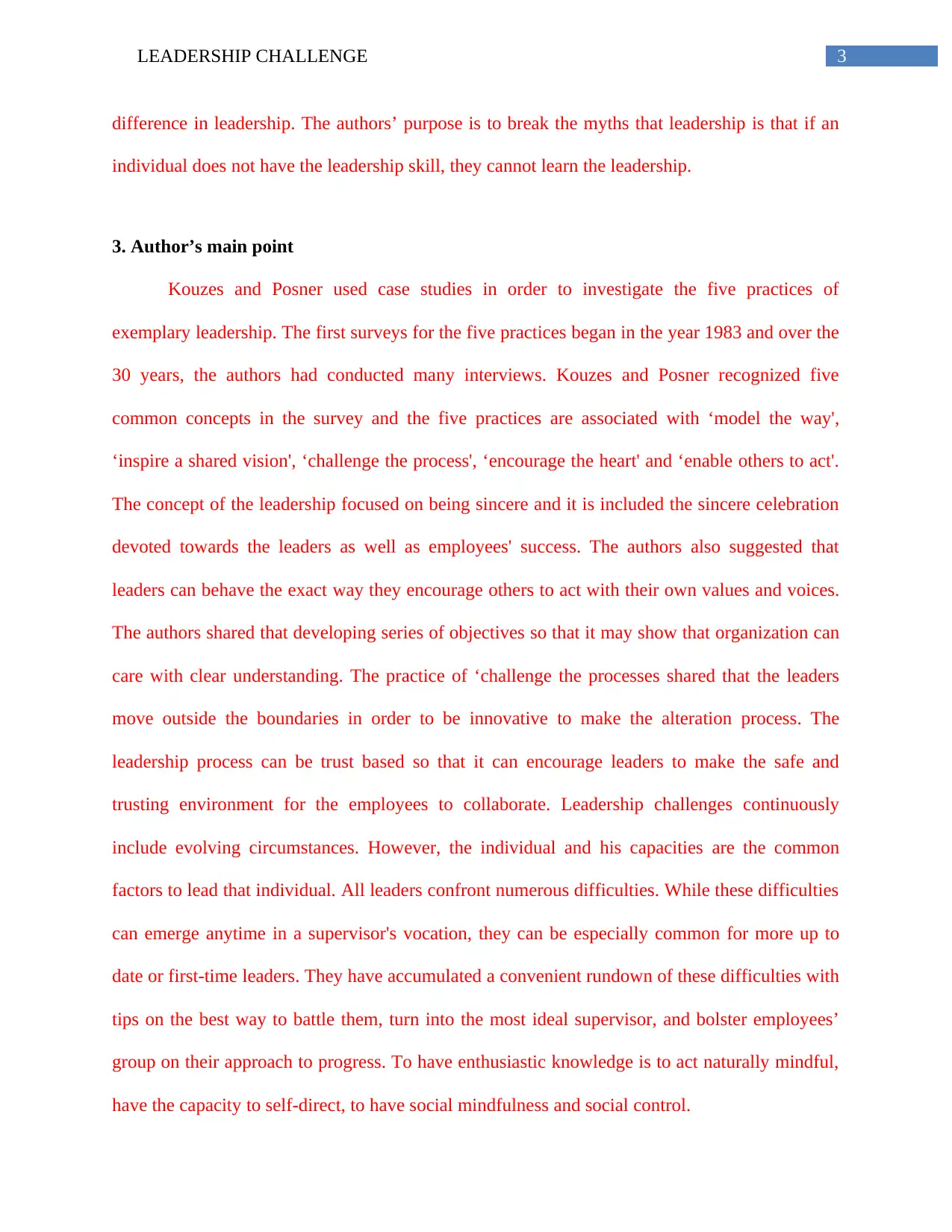
3LEADERSHIP CHALLENGE
difference in leadership. The authors’ purpose is to break the myths that leadership is that if an
individual does not have the leadership skill, they cannot learn the leadership.
3. Author’s main point
Kouzes and Posner used case studies in order to investigate the five practices of
exemplary leadership. The first surveys for the five practices began in the year 1983 and over the
30 years, the authors had conducted many interviews. Kouzes and Posner recognized five
common concepts in the survey and the five practices are associated with ‘model the way',
‘inspire a shared vision', ‘challenge the process', ‘encourage the heart' and ‘enable others to act'.
The concept of the leadership focused on being sincere and it is included the sincere celebration
devoted towards the leaders as well as employees' success. The authors also suggested that
leaders can behave the exact way they encourage others to act with their own values and voices.
The authors shared that developing series of objectives so that it may show that organization can
care with clear understanding. The practice of ‘challenge the processes shared that the leaders
move outside the boundaries in order to be innovative to make the alteration process. The
leadership process can be trust based so that it can encourage leaders to make the safe and
trusting environment for the employees to collaborate. Leadership challenges continuously
include evolving circumstances. However, the individual and his capacities are the common
factors to lead that individual. All leaders confront numerous difficulties. While these difficulties
can emerge anytime in a supervisor's vocation, they can be especially common for more up to
date or first-time leaders. They have accumulated a convenient rundown of these difficulties with
tips on the best way to battle them, turn into the most ideal supervisor, and bolster employees’
group on their approach to progress. To have enthusiastic knowledge is to act naturally mindful,
have the capacity to self-direct, to have social mindfulness and social control.
difference in leadership. The authors’ purpose is to break the myths that leadership is that if an
individual does not have the leadership skill, they cannot learn the leadership.
3. Author’s main point
Kouzes and Posner used case studies in order to investigate the five practices of
exemplary leadership. The first surveys for the five practices began in the year 1983 and over the
30 years, the authors had conducted many interviews. Kouzes and Posner recognized five
common concepts in the survey and the five practices are associated with ‘model the way',
‘inspire a shared vision', ‘challenge the process', ‘encourage the heart' and ‘enable others to act'.
The concept of the leadership focused on being sincere and it is included the sincere celebration
devoted towards the leaders as well as employees' success. The authors also suggested that
leaders can behave the exact way they encourage others to act with their own values and voices.
The authors shared that developing series of objectives so that it may show that organization can
care with clear understanding. The practice of ‘challenge the processes shared that the leaders
move outside the boundaries in order to be innovative to make the alteration process. The
leadership process can be trust based so that it can encourage leaders to make the safe and
trusting environment for the employees to collaborate. Leadership challenges continuously
include evolving circumstances. However, the individual and his capacities are the common
factors to lead that individual. All leaders confront numerous difficulties. While these difficulties
can emerge anytime in a supervisor's vocation, they can be especially common for more up to
date or first-time leaders. They have accumulated a convenient rundown of these difficulties with
tips on the best way to battle them, turn into the most ideal supervisor, and bolster employees’
group on their approach to progress. To have enthusiastic knowledge is to act naturally mindful,
have the capacity to self-direct, to have social mindfulness and social control.
Paraphrase This Document
Need a fresh take? Get an instant paraphrase of this document with our AI Paraphraser
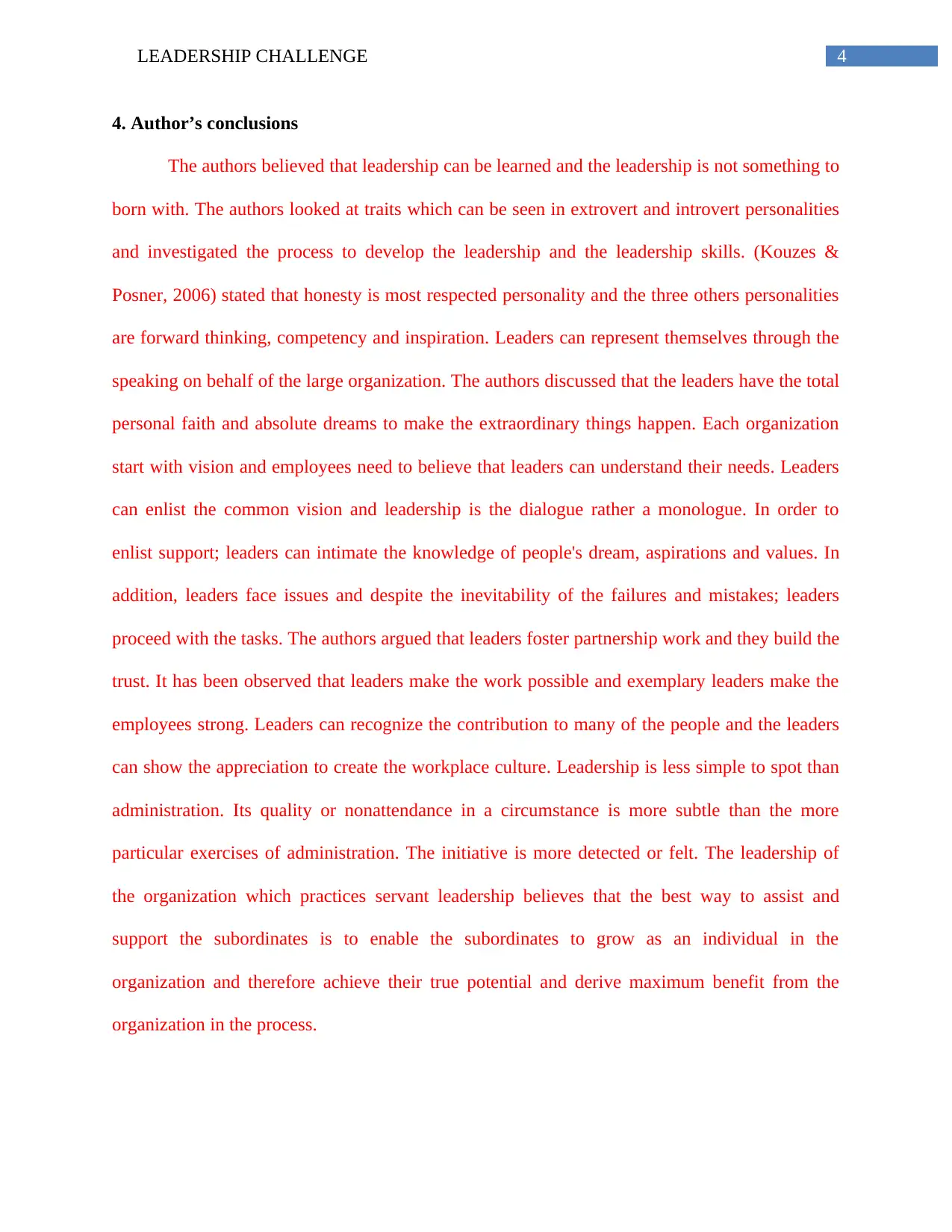
4LEADERSHIP CHALLENGE
4. Author’s conclusions
The authors believed that leadership can be learned and the leadership is not something to
born with. The authors looked at traits which can be seen in extrovert and introvert personalities
and investigated the process to develop the leadership and the leadership skills. (Kouzes &
Posner, 2006) stated that honesty is most respected personality and the three others personalities
are forward thinking, competency and inspiration. Leaders can represent themselves through the
speaking on behalf of the large organization. The authors discussed that the leaders have the total
personal faith and absolute dreams to make the extraordinary things happen. Each organization
start with vision and employees need to believe that leaders can understand their needs. Leaders
can enlist the common vision and leadership is the dialogue rather a monologue. In order to
enlist support; leaders can intimate the knowledge of people's dream, aspirations and values. In
addition, leaders face issues and despite the inevitability of the failures and mistakes; leaders
proceed with the tasks. The authors argued that leaders foster partnership work and they build the
trust. It has been observed that leaders make the work possible and exemplary leaders make the
employees strong. Leaders can recognize the contribution to many of the people and the leaders
can show the appreciation to create the workplace culture. Leadership is less simple to spot than
administration. Its quality or nonattendance in a circumstance is more subtle than the more
particular exercises of administration. The initiative is more detected or felt. The leadership of
the organization which practices servant leadership believes that the best way to assist and
support the subordinates is to enable the subordinates to grow as an individual in the
organization and therefore achieve their true potential and derive maximum benefit from the
organization in the process.
4. Author’s conclusions
The authors believed that leadership can be learned and the leadership is not something to
born with. The authors looked at traits which can be seen in extrovert and introvert personalities
and investigated the process to develop the leadership and the leadership skills. (Kouzes &
Posner, 2006) stated that honesty is most respected personality and the three others personalities
are forward thinking, competency and inspiration. Leaders can represent themselves through the
speaking on behalf of the large organization. The authors discussed that the leaders have the total
personal faith and absolute dreams to make the extraordinary things happen. Each organization
start with vision and employees need to believe that leaders can understand their needs. Leaders
can enlist the common vision and leadership is the dialogue rather a monologue. In order to
enlist support; leaders can intimate the knowledge of people's dream, aspirations and values. In
addition, leaders face issues and despite the inevitability of the failures and mistakes; leaders
proceed with the tasks. The authors argued that leaders foster partnership work and they build the
trust. It has been observed that leaders make the work possible and exemplary leaders make the
employees strong. Leaders can recognize the contribution to many of the people and the leaders
can show the appreciation to create the workplace culture. Leadership is less simple to spot than
administration. Its quality or nonattendance in a circumstance is more subtle than the more
particular exercises of administration. The initiative is more detected or felt. The leadership of
the organization which practices servant leadership believes that the best way to assist and
support the subordinates is to enable the subordinates to grow as an individual in the
organization and therefore achieve their true potential and derive maximum benefit from the
organization in the process.

5LEADERSHIP CHALLENGE
5. Convergence/ divergence
Transactional Leadership
The transactional leadership is a style of leadership which concentrates on the aspect of
supervision, organization as well as enhancing the performance of the organization. The
transactional leadership focuses on the aspect of promoting the clients based on their ability to
conform to a given situation and whether or not the clients are able to respond to the needs and
requirement of the jobs and the profession which they are entitled to perform (De Matthews &
Mawhinney, 2014). The transactional leaders assess the performance of the subordinates and the
workers and they motivate the best performing employees and the subordinates by awarding and
giving recognition to such employees and workers. The transactional leaders try to manage the
organizational hierarchy by allocating specific roles to the employees and the organizational
leaders who follow the transactional form of leadership reprimand the workers and the workers
who have not been able to perform to the best of their abilities (De Paoli & Ropo, 2015). The
transactional form of leadership entails the necessity to utilize the potential of the workers and
the subordinates in the various aspects of the organization and these nuances, which are
significant aspect s of the organization, play a dominant role in the running of the organization.
Kouzes and Posner stated that transactional leaders essentially motivate the subordinates that
exchange the performance of the leaders.
Transformational Leadership
The transformational leadership is this leadership wherein the leaders inspire the
subordinates to perform at the best of their potential and the leaders transform the subordinates
as well as the employees of the organization to realize their maximum potential. The
5. Convergence/ divergence
Transactional Leadership
The transactional leadership is a style of leadership which concentrates on the aspect of
supervision, organization as well as enhancing the performance of the organization. The
transactional leadership focuses on the aspect of promoting the clients based on their ability to
conform to a given situation and whether or not the clients are able to respond to the needs and
requirement of the jobs and the profession which they are entitled to perform (De Matthews &
Mawhinney, 2014). The transactional leaders assess the performance of the subordinates and the
workers and they motivate the best performing employees and the subordinates by awarding and
giving recognition to such employees and workers. The transactional leaders try to manage the
organizational hierarchy by allocating specific roles to the employees and the organizational
leaders who follow the transactional form of leadership reprimand the workers and the workers
who have not been able to perform to the best of their abilities (De Paoli & Ropo, 2015). The
transactional form of leadership entails the necessity to utilize the potential of the workers and
the subordinates in the various aspects of the organization and these nuances, which are
significant aspect s of the organization, play a dominant role in the running of the organization.
Kouzes and Posner stated that transactional leaders essentially motivate the subordinates that
exchange the performance of the leaders.
Transformational Leadership
The transformational leadership is this leadership wherein the leaders inspire the
subordinates to perform at the best of their potential and the leaders transform the subordinates
as well as the employees of the organization to realize their maximum potential. The
⊘ This is a preview!⊘
Do you want full access?
Subscribe today to unlock all pages.

Trusted by 1+ million students worldwide

6LEADERSHIP CHALLENGE
transformational leadership enables the free flow of the ability to effectively utilize the
leadership skills in order to maximize the potential and the ability of the subordinate and the
workers to realize their true potential and therefore maximize the impact of their work and
efficiency (Hopkins et al., 2014). Kouzes and Posner talked about Transformational Leadership
that provides practical guidance on leading the people with a practical suggestion.
Servant Leadership
The Servant Leadership is the traditional leadership design which is used to exercise the
power at the top of the pyramid basis and emphasizes on the servant leader sharing of power
analysis. The relationship amongst the servant leaders in the organizational management enables
the efficiency of the organization to function in a very effective and efficient manner (Carter &
Baghurst, 2014). When the leaders shift their mindset from the above-allocated services, then the
activities which are served by the people for the welfare of the servants and the employees are
known as the servant leadership. The existence of the servant leadership is of prime importance
for the organizational leadership because the best type of the leaders is the one whose existence
makes the people secure and the subordinates, as well as the people at the bottom of the
hierarchy; love the rulers and the leaders at the top of the pyramid.
6. Relevance
The authors stated that envision the future by imagining ennobling possibility can be the
shared vision of the leaders. The authors also discussed on enlisting common vision by the
shared aspirations and appealing stories. The leaders must have the clear vision in mind and the
authors can clear the process why the leadership is important. Furthermore, the leaders can make
it clear why they should matter to those to share the vision with. Kouzes and Posner concluded
transformational leadership enables the free flow of the ability to effectively utilize the
leadership skills in order to maximize the potential and the ability of the subordinate and the
workers to realize their true potential and therefore maximize the impact of their work and
efficiency (Hopkins et al., 2014). Kouzes and Posner talked about Transformational Leadership
that provides practical guidance on leading the people with a practical suggestion.
Servant Leadership
The Servant Leadership is the traditional leadership design which is used to exercise the
power at the top of the pyramid basis and emphasizes on the servant leader sharing of power
analysis. The relationship amongst the servant leaders in the organizational management enables
the efficiency of the organization to function in a very effective and efficient manner (Carter &
Baghurst, 2014). When the leaders shift their mindset from the above-allocated services, then the
activities which are served by the people for the welfare of the servants and the employees are
known as the servant leadership. The existence of the servant leadership is of prime importance
for the organizational leadership because the best type of the leaders is the one whose existence
makes the people secure and the subordinates, as well as the people at the bottom of the
hierarchy; love the rulers and the leaders at the top of the pyramid.
6. Relevance
The authors stated that envision the future by imagining ennobling possibility can be the
shared vision of the leaders. The authors also discussed on enlisting common vision by the
shared aspirations and appealing stories. The leaders must have the clear vision in mind and the
authors can clear the process why the leadership is important. Furthermore, the leaders can make
it clear why they should matter to those to share the vision with. Kouzes and Posner concluded
Paraphrase This Document
Need a fresh take? Get an instant paraphrase of this document with our AI Paraphraser
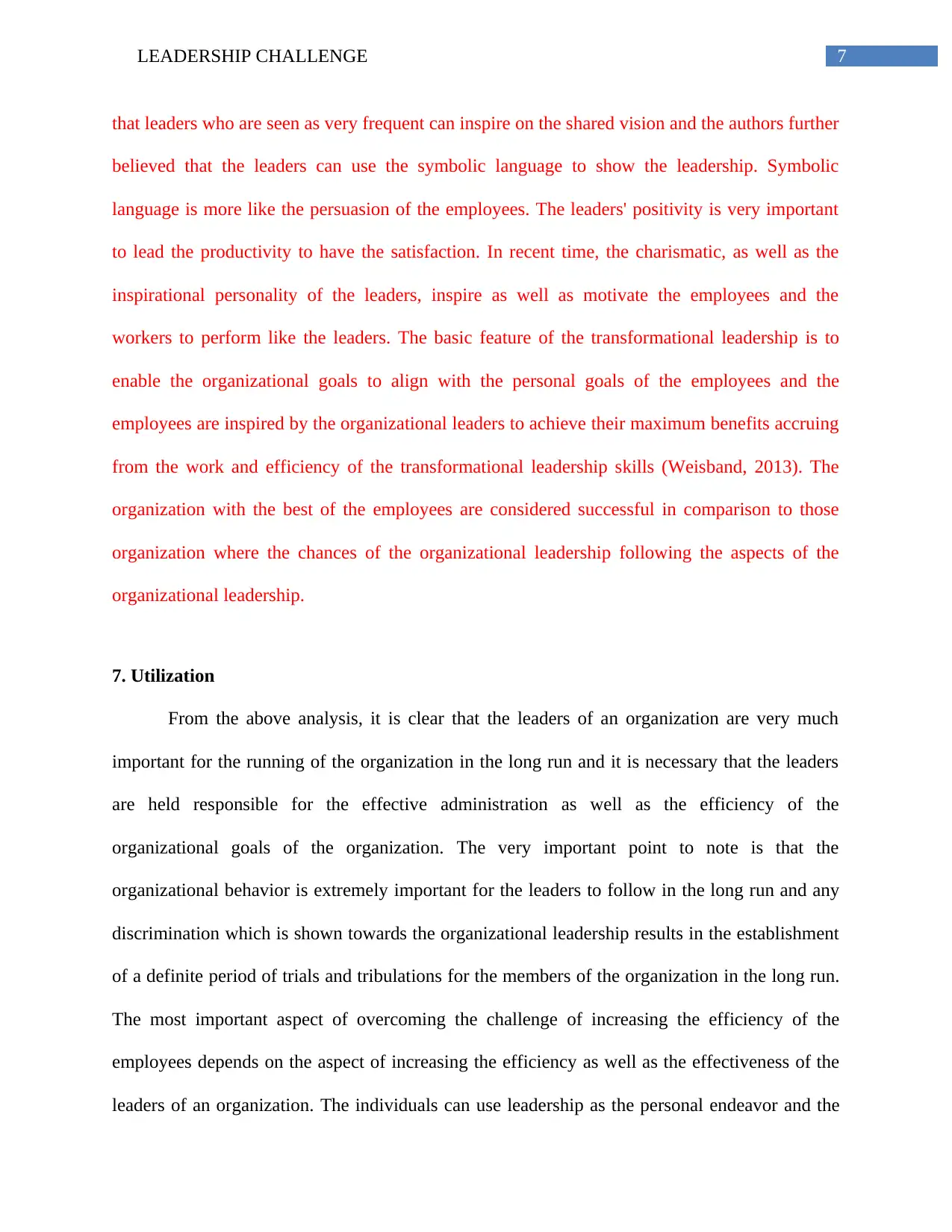
7LEADERSHIP CHALLENGE
that leaders who are seen as very frequent can inspire on the shared vision and the authors further
believed that the leaders can use the symbolic language to show the leadership. Symbolic
language is more like the persuasion of the employees. The leaders' positivity is very important
to lead the productivity to have the satisfaction. In recent time, the charismatic, as well as the
inspirational personality of the leaders, inspire as well as motivate the employees and the
workers to perform like the leaders. The basic feature of the transformational leadership is to
enable the organizational goals to align with the personal goals of the employees and the
employees are inspired by the organizational leaders to achieve their maximum benefits accruing
from the work and efficiency of the transformational leadership skills (Weisband, 2013). The
organization with the best of the employees are considered successful in comparison to those
organization where the chances of the organizational leadership following the aspects of the
organizational leadership.
7. Utilization
From the above analysis, it is clear that the leaders of an organization are very much
important for the running of the organization in the long run and it is necessary that the leaders
are held responsible for the effective administration as well as the efficiency of the
organizational goals of the organization. The very important point to note is that the
organizational behavior is extremely important for the leaders to follow in the long run and any
discrimination which is shown towards the organizational leadership results in the establishment
of a definite period of trials and tribulations for the members of the organization in the long run.
The most important aspect of overcoming the challenge of increasing the efficiency of the
employees depends on the aspect of increasing the efficiency as well as the effectiveness of the
leaders of an organization. The individuals can use leadership as the personal endeavor and the
that leaders who are seen as very frequent can inspire on the shared vision and the authors further
believed that the leaders can use the symbolic language to show the leadership. Symbolic
language is more like the persuasion of the employees. The leaders' positivity is very important
to lead the productivity to have the satisfaction. In recent time, the charismatic, as well as the
inspirational personality of the leaders, inspire as well as motivate the employees and the
workers to perform like the leaders. The basic feature of the transformational leadership is to
enable the organizational goals to align with the personal goals of the employees and the
employees are inspired by the organizational leaders to achieve their maximum benefits accruing
from the work and efficiency of the transformational leadership skills (Weisband, 2013). The
organization with the best of the employees are considered successful in comparison to those
organization where the chances of the organizational leadership following the aspects of the
organizational leadership.
7. Utilization
From the above analysis, it is clear that the leaders of an organization are very much
important for the running of the organization in the long run and it is necessary that the leaders
are held responsible for the effective administration as well as the efficiency of the
organizational goals of the organization. The very important point to note is that the
organizational behavior is extremely important for the leaders to follow in the long run and any
discrimination which is shown towards the organizational leadership results in the establishment
of a definite period of trials and tribulations for the members of the organization in the long run.
The most important aspect of overcoming the challenge of increasing the efficiency of the
employees depends on the aspect of increasing the efficiency as well as the effectiveness of the
leaders of an organization. The individuals can use leadership as the personal endeavor and the
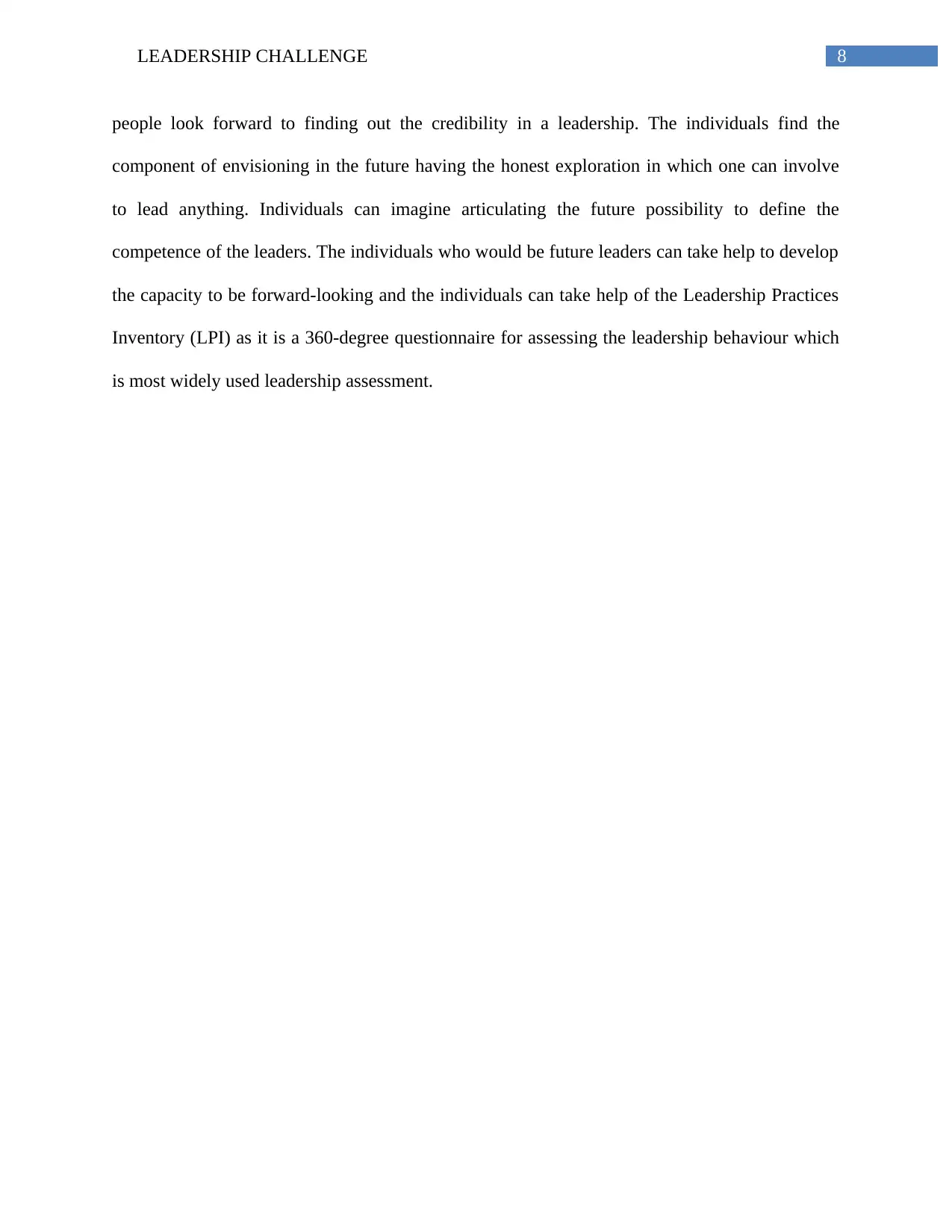
8LEADERSHIP CHALLENGE
people look forward to finding out the credibility in a leadership. The individuals find the
component of envisioning in the future having the honest exploration in which one can involve
to lead anything. Individuals can imagine articulating the future possibility to define the
competence of the leaders. The individuals who would be future leaders can take help to develop
the capacity to be forward-looking and the individuals can take help of the Leadership Practices
Inventory (LPI) as it is a 360-degree questionnaire for assessing the leadership behaviour which
is most widely used leadership assessment.
people look forward to finding out the credibility in a leadership. The individuals find the
component of envisioning in the future having the honest exploration in which one can involve
to lead anything. Individuals can imagine articulating the future possibility to define the
competence of the leaders. The individuals who would be future leaders can take help to develop
the capacity to be forward-looking and the individuals can take help of the Leadership Practices
Inventory (LPI) as it is a 360-degree questionnaire for assessing the leadership behaviour which
is most widely used leadership assessment.
⊘ This is a preview!⊘
Do you want full access?
Subscribe today to unlock all pages.

Trusted by 1+ million students worldwide

9LEADERSHIP CHALLENGE
Reference List
AbuAlRub, R.F. & Nasrallah, M.A., (2017). Leadership behaviours, organizational culture and
intention to stay amongst Jordanian nurses. International nursing review, 64(4), 520-527.
Carter, D., & Baghurst, T. (2014). The influence of servant leadership on restaurant employee
engagement. Journal of Business Ethics, 124(3), 453-464.
De Paoli, D., & Ropo, A. (2015). Open plan offices–the response to leadership challenges of
virtual project work?. Journal of Corporate Real Estate, 17(1), 63-74.
DeMatthews, D., & Mawhinney, H. (2014). Social justice leadership and inclusion: Exploring
challenges in an urban district struggling to address inequities. Educational
Administration Quarterly, 50(5), 844-881.
Hopkins, K., Meyer, M., Shera, W., & Peters, S. C. (2014). Leadership challenges facing
nonprofit human service organizations in a post-recession era. Human Service
Organizations: Management, Leadership & Governance, 38(5), 419-422.
Kouzes, J.M. & Posner, B.Z., (2006). The leadership challenge (Vol. 3). New Jersey: John Wiley
& Sons.
Weisband, S. P. (Ed.). (2013). Leadership at a distance: research in technologically-supported
work. London: Psychology Press.
Reference List
AbuAlRub, R.F. & Nasrallah, M.A., (2017). Leadership behaviours, organizational culture and
intention to stay amongst Jordanian nurses. International nursing review, 64(4), 520-527.
Carter, D., & Baghurst, T. (2014). The influence of servant leadership on restaurant employee
engagement. Journal of Business Ethics, 124(3), 453-464.
De Paoli, D., & Ropo, A. (2015). Open plan offices–the response to leadership challenges of
virtual project work?. Journal of Corporate Real Estate, 17(1), 63-74.
DeMatthews, D., & Mawhinney, H. (2014). Social justice leadership and inclusion: Exploring
challenges in an urban district struggling to address inequities. Educational
Administration Quarterly, 50(5), 844-881.
Hopkins, K., Meyer, M., Shera, W., & Peters, S. C. (2014). Leadership challenges facing
nonprofit human service organizations in a post-recession era. Human Service
Organizations: Management, Leadership & Governance, 38(5), 419-422.
Kouzes, J.M. & Posner, B.Z., (2006). The leadership challenge (Vol. 3). New Jersey: John Wiley
& Sons.
Weisband, S. P. (Ed.). (2013). Leadership at a distance: research in technologically-supported
work. London: Psychology Press.
1 out of 10
Related Documents
Your All-in-One AI-Powered Toolkit for Academic Success.
+13062052269
info@desklib.com
Available 24*7 on WhatsApp / Email
![[object Object]](/_next/static/media/star-bottom.7253800d.svg)
Unlock your academic potential
© 2024 | Zucol Services PVT LTD | All rights reserved.
![Leadership Analysis: Kouzes and Posner Model Report, [University Name]](/_next/image/?url=https%3A%2F%2Fdesklib.com%2Fmedia%2Fimages%2Fhm%2Fafce88564314430eb83ad6a486b26457.jpg&w=256&q=75)




